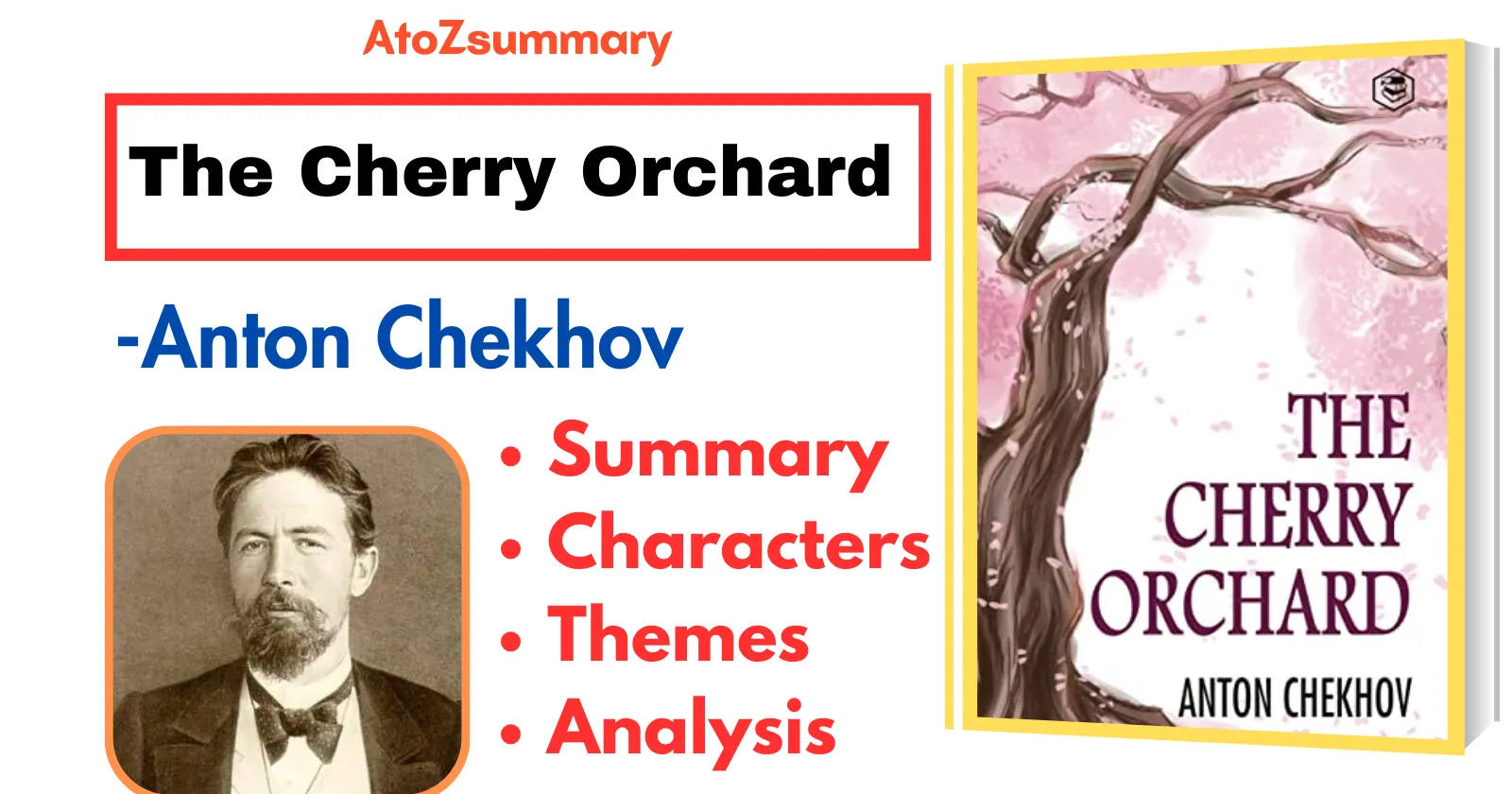About the Play: The Cherry Orchard
| Title | The Cherry Orchard |
| Playwright | Anton Chekhov |
| Premiere | 1904 |
| Setting | Russia, early 20th century |
| Plot Overview | The Ranevskaya family faces financial crisis and the impending auction of their estate, including the iconic cherry orchard. |
| Symbolism | The cherry orchard represents the past and the inevitability of change. The sound of the axe cutting down the trees symbolizes the end of an era. |
| Tone | Tragicomedy, blending elements of both comedy and tragedy |
| Famous Quotes | “If you have no aim in life, if you do not strive towards something higher, you will sooner or later have to pay for your idleness with troubles and grief.” – Trofimov |
| Ending | The family loses the estate in the auction, and the cherry orchard is cut down. The play concludes with the sound of a departing train, symbolizing the characters’ dispersion and the end of an era. |
Analysis: The Cherry Orchard
“The Cherry Orchard” by Anton Chekhov is a classic play that revolves around the Ranevskaya family and their estate, including a beloved cherry orchard. The family faces financial difficulties and must decide whether to save the estate or allow it to be auctioned.
The characters, including the eccentric businessman Lopakhin and the idealistic student Trofimov, represent different perspectives on life. The cherry orchard itself becomes a symbol of the past, and its eventual fate reflects the inevitability of change. Overall, Chekhov’s play is a poignant portrayal of the complexities of human relationships and the passage of time.
Characters: The Cherry Orchard
The characters of “The Cherry Orchard” by Anton Chekhov are:
- Lyuba Ranevskaya: The owner of the estate, kind-hearted but impractical. She’s nostalgic for the past and struggles with the impending loss of the cherry orchard.
- Leonid Gayev: Lyuba’s brother, optimistic but somewhat clueless about financial matters. He wants to save the estate but doesn’t have a clear plan.
- Anya: Lyuba’s daughter, a young and hopeful character. She represents the new generation and the future.
- Lopakhin: A wealthy businessman with humble origins. He suggests cutting down the cherry orchard and building summer cottages to save the estate, but faces resistance.
- Firs: An elderly servant on the estate, loyal but forgotten. He symbolizes the fading past and the changing times.
- Peter Trofimov: A student and philosopher, often critical of society. He’s in love with Anya and represents the intellectual and idealistic side of the younger generation.
- Charlotta Ivanovna: A governess and entertainer, somewhat mysterious. She brings an element of whimsy to the play.
- Boris Simeonov-Pishchik: A friend of the family, always in financial trouble. He adds humor to the play with his constant requests for money.
- Yasha: A young servant with modern aspirations. He represents the shift in social dynamics and the emerging class struggle.
- Yepikhodov: A clerk with bad luck, known for constantly injuring himself. His misfortunes contribute to the play’s tragicomic atmosphere.
Themes: The Cherry Orchard
- Change and Transition: The play explores the theme of societal and personal change as characters grapple with the transition from an old way of life to a new one.
- Class Struggle: “The Cherry Orchard” looks into the tensions between different social classes, highlighting the impact of societal shifts on the privileged aristocracy and the emerging middle class.
- Nostalgia and Loss: There’s a pervasive sense of nostalgia and loss as characters confront the inevitable loss of the cherry orchard and the fading of the past.
- Illusion vs. Reality: The play examines the contrast between characters’ illusions, dreams, and the harsh reality of their situations, adding layers to their relationships and decisions.
- Symbolism of the Cherry Orchard: The cherry orchard serves as a powerful symbol, representing the vanishing way of life, the passage of time, and the characters’ emotional attachments to the past.
- Human Frailty and Complexity: Chekhov portrays the human condition with its flaws and complexities, emphasizing the vulnerability and unpredictability of human behavior.
- Unfulfilled Love and Relationships: The play explores the theme of unfulfilled love and the complexities of human relationships, with characters struggling to express their true feelings.
- Economic and Social Upheaval: The backdrop of economic and social change in Russia during the early 20th century is a key theme, influencing the characters’ lives and decisions.
The themes of “The Cherry Orchard” by Anton Chekhov are:
Watch Full Play Summary of “The Cherry Orchard”
Summary
A group of Russians’ lives following the liberation of the serfs are described in The Cherry Orchard. Although the play spans five or six months, the characters’ complicated pasts make it feel as though the action started years earlier.
Inside the cherry orchard estate, friends, neighbors, and staff are getting ready for Madame Ranevsky, the house’s mistress, and her daughter Anya’s long-awaited homecoming in May, when the play starts. Madame Ranevsky is a mother of two girls. Five years prior, she had left the cherry orchard following the deaths of her husband and little son. She had been plundered and left by her violent lover in France, and now she is returning. During her absence, she has racked up significant debt.
Starting with his personal success story, Lopakhin describes how he went from being born into a serf family to being a wealthy man. First, another ex-serf prepares the house for Lopakhin’s talks. Despite the Liberation, Firs has continued to upload the same content every time. Dunyasha admits that she and Ephikhodof may become lovers, but nobody seems to be interested.
Madame Ranevsky reappears at last. Her relatives and friends are ecstatic to see her. Act I introduces several subplots, including the romance between Anya and her tutor Trophimof, the hopeful romance between her sister Barbara and the wealthy Lopakhin, the love triangle between Dunyasha, Yasha, and Ephikhodof, the neighbor Pishtchik’s debt, Lopakhin and Firs’ class struggles, Charlotte’s isolation, and more. The play’s primary mystery, nevertheless, is related to Madame Ranevsky’s debt. The mortgage on the cherry orchard estate is above her and her brother Gayef’s means, and the state is scheduled to go up for auction in August if they can’t come up with a solution.
Lopakhin proposes that Madame Ranevsky develop the site with villas. She may rent them out and utilize the proceeds to cover her mortgage. Madame Ranevsky and Gayef are against the proposal and would rather solve their problems. But as spring gives way to summer, Madame Ranevsky keeps accruing debt and doesn’t see a way out. While nothing happens between Lopakhin & Barbara and Dunyasha and Ephikhodof, strange romances continue between Anya and Trophimof and Dunyasha and Yasha. First is becoming sicker. As a result of Madame Ranevsky getting letters from her boyfriend, Gayef starts thinking about applying for jobs at banks. Pishtchik borrows money from Madame Ranevsky, whose own reserves are running short.
There is still no resolution on the eve of the sale. Ball in Madame Ranevsky’s hand. Both staff and visitors dance when Charlotte performs. Trophimof and Madame Ranevsky had a serious discussion about Madame Ranevsky’s extravagant spending. In addition to her mounting debt, Madame Ranevsky is thinking of going back to her violent boyfriend in France. Madame Ranevsky is anxious about the auction’s result and is still holding out hope for a miracle.
In the final act, the once-grand estate of the Ranevsky family is auctioned off, marking the end of an era and the loss of their beloved cherry orchard. As the new owner, Lopakhin, prepares to transform the land for development, the characters grapple with the weight of their past and the uncertainty of their future.
Amidst the packing and preparations for departure, Ranevsky and Gayev, the former owners, find themselves reliving memories of their past grandeur, unable to fully accept the reality of their situation. They linger in the house, clinging to remnants of their former lives, as the sound of axes chopping down the cherry trees echoes in the distance.
In a moment of quiet reflection, Anya, Ranevsky’s daughter, expresses her determination to move on and build a new life for herself. She encourages her mother to do the same, assuring her that they will find happiness elsewhere.
As the characters gather for one last farewell, they bid goodbye to their home, carrying with them the memories of a bygone era and the hope for a brighter future. The play ends with the sound of an axe striking a tree in the orchard, symbolizing the end of an old chapter and the beginning of a new one.
FAQs
What is The Cherry Orchard about?
The Cherry Orchard is about a family losing their house and favorite orchard, dealing with change and saying goodbye to the past.
What is the point of The Cherry Orchard?
The Cherry Orchard is a play about the decline of the Russian aristocracy and the rise of the new Russian bourgeoisie.
What is the moral of The Cherry Orchard?
The Cherry Orchard suggests that clinging to the past can prevent progress and that embracing change is necessary for adapting to new realities.
What is the main conflict in The Cherry Orchard?
The main conflict is the family’s struggle to save their estate from being sold due to financial troubles.
What makes The Cherry Orchard a tragedy?
The Cherry Orchard is a tragedy because it tells a sad story about a family losing their cherished home and the old way of life.
What does the nursery symbolize in The Cherry Orchard?
The nursery symbolizes cherished memories and the family’s connection to the past, reflecting the emotional attachment to the estate.
What happens to the orchard in The Cherry Orchard?
The orchard gets sold in an auction and the trees are chopped down.
Who goes to Paris with Madame Ranevskaya at the end of the play?
Madame Ranevskaya goes to Paris with her daughter Anya at the end of the play.
What happens at the end of cherry orchard?
At the end of “The Cherry Orchard,” the family loses their estate, the cherished cherry orchard is cut down, and the characters face a new chapter in their lives.











